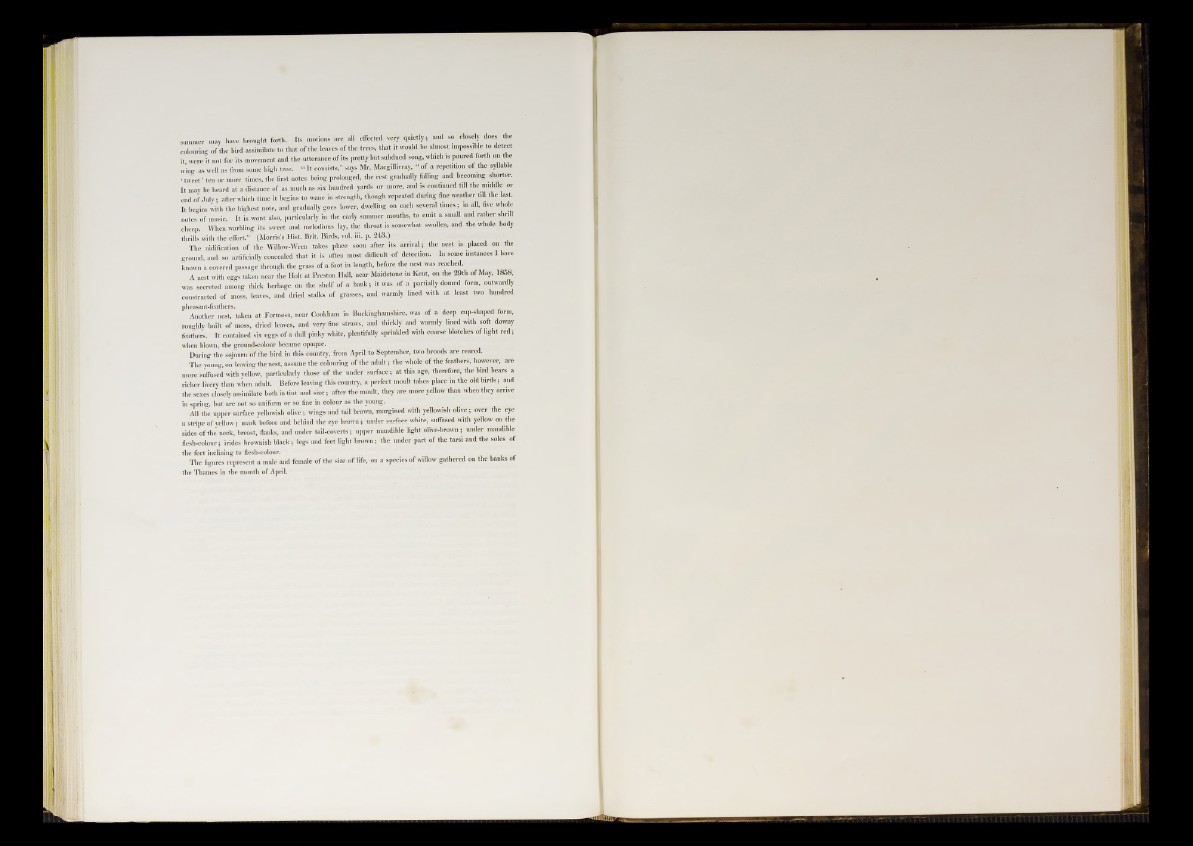
summer may have brought forth. Its motions are all effected very quietly, and so closely does the
colouring of the bird assimilate to that of the leaves of the trees, that it would be almost impossible to detect
it were it not for Its movement and the utterance o f its pretty bnt subdued song, which is poured forth on the
wing us well as from some high tree. | It consists,” says Mr. MacgiUivray, I of a repetition of the syllable
•tweet' ten or more times, the first notes being prolonged, the rest gradually falling and becoming shorter.
It may be heard at a distance of as much as six hundred yards or more, and is continued till the middle or
end of Ju ly , after which time it begins to wane in strength, though repeated during fine weather till the last.
It begins with the highest note, and gradually goes lower, dwelling on each several times, g all, five whole
notes of music. It is wont also, particularly in the early summer months, to emit a small and rather shrill
cheep. When warbling its sweet and melodious lay, the throat is somewhat swollen, and the whole body
thrills with the effort.” (Morris’s Hist. Brit. Birds, vol. iii. p. 243.)
The uidificatlon of the Willow-Wren takes place soon after its arrival, the nest is placed on the
ground, and so artificially concealed that it Is often most difficult of detection. In some instances I have
known a covered passage through the grass of a foot in length, before the nest was reached.
A nest with eggs taken near the Holt at Preston Hall, near Maidstone in Kent, on the 29th of May, 1858,
was secreted among thick herbage on the shelf of a bank; it was of a partially domed form, outwardly
constructed of moss, leaves, and dried stalks of grasses, and warmly lined with at least two hundred
pheasant-feathers.
Another nest, taken at Formosa, near Cookham in Buckinghamshire, was of a deep cup-shaped form,
roughly built of moss, dried leaves, and very fine straws, and thickly and warmly lined with soft downy
feathers. It contained six eggs of a dull pinky white, plentifidly sprinkled with coarse blotches of light red ;
when blown, the ground-colour became opaque.
During the sojourn of the bird in this country, from April to September, two broods are reared.
The young, on leaving the nest, assume the colouring of the adult, the whole of the feathers, however, are
more snflbsed with yellow, particularly those of the under surface; at this age, therefore, the bird bears a
richer livery than when adult. Before leaving this country, a perfect moult takes place in the old birds; and
the sexes closely assimilate both in tint and sire ; after the moult, they are more yellow than when they arrive
in spring, but are not so uniform or so fine in colour as the young.
All the upper snrlace yellowish olive; wings and tall brown, margined with yellowish olive; over the eye
a stripe of yellow; mark before and behind the eye brown; under surface white, suffused with yellow on the
sides of the neck, breast, flanks, and under tail-coverts; upper mandible light olive-brown; under mandible
flesh-colour, irides brownish black, legs and feet light brown; the nnder part of the tarsi and the soles of
the feet inclining to flesh-colour.
The figures represent a male and female of the size of life, on a species of willow gathered on the banks of
the Thames in the month of April.